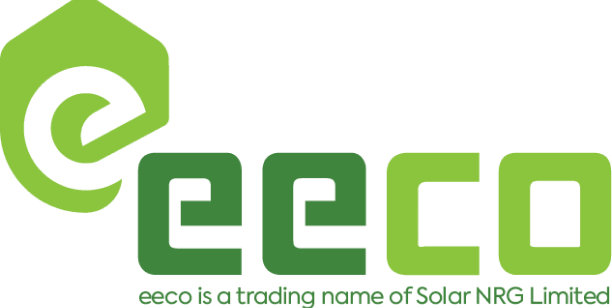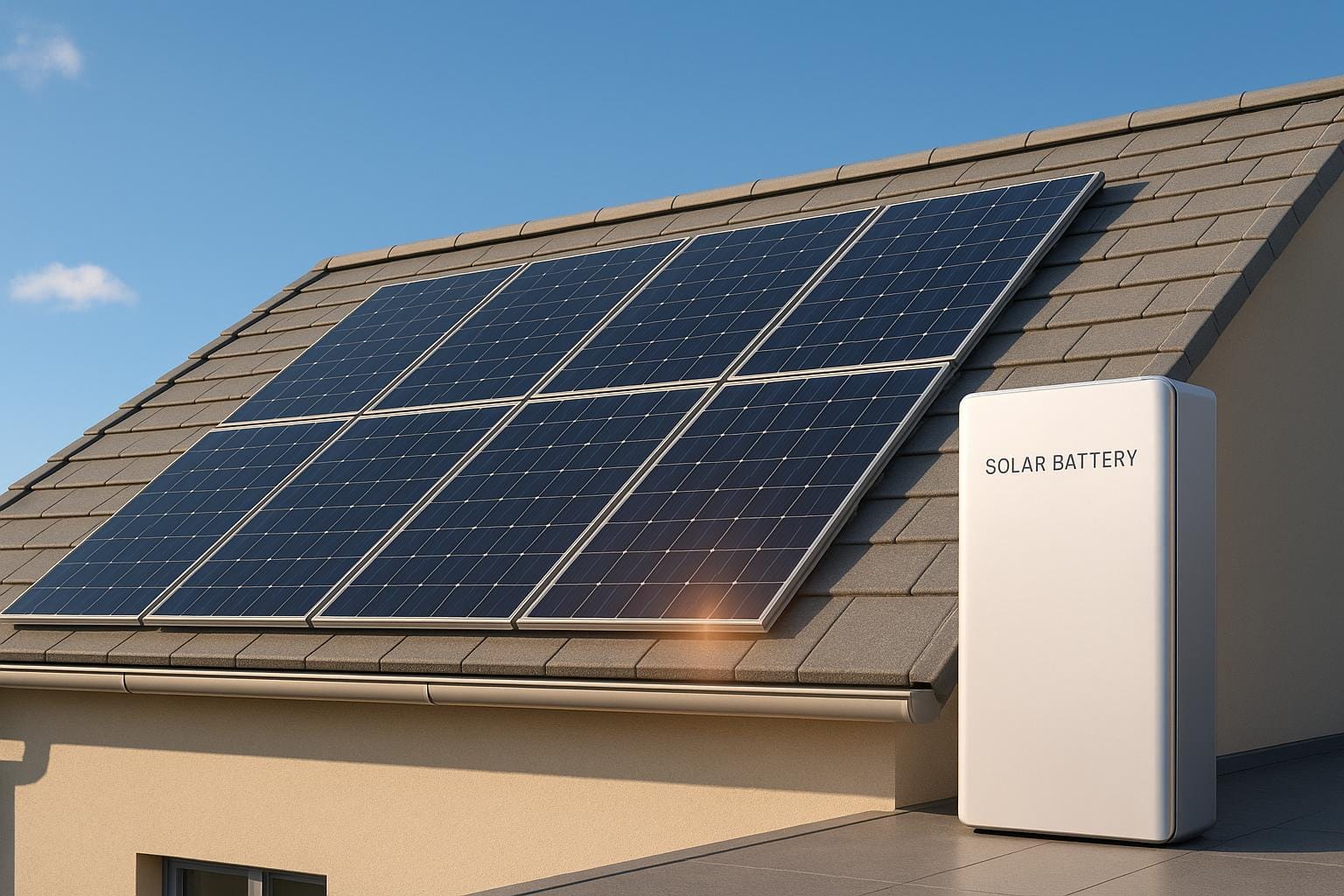Solar battery systems store excess energy from solar panels, helping you save on electricity bills and reduce reliance on the grid. Choosing the right system depends on your energy needs, budget, and compatibility with your solar setup. Here’s a quick summary of the top options:
- EECO Energy Duracell: Modular and reliable, with a 10-year warranty. Costs £3,500–£7,000 for 5–20 kWh.
- Tesla Powerwall: High capacity (13.5 kWh) and advanced features. Costs £8,000–£12,000.
- LG Chem RESU: Compact and efficient, with models ranging from 3.3–16 kWh. Costs £4,000–£8,500.
- SonnenBatterie: Premium smart systems with long warranties. Costs £9,000–£15,000.
- Huawei Luna: Affordable and stackable, with capacities from 5–30 kWh. Costs £2,600–£6,000, but only works with Huawei inverters.
Quick Comparison:
| System Name | Capacity | Efficiency | Warranty | Cost (£) | Key Features | Compatibility |
|---|---|---|---|---|---|---|
| EECO Energy Duracell | 5–20 kWh | 95%+ | 10 years | £3,500–£7,000 | Modular, local support | Most inverters |
| Tesla Powerwall | 13.5 kWh | 90% | 10 years | £8,000–£12,000 | High capacity, app control | Tesla ecosystem |
| LG Chem RESU | 3.3–16 kWh | 95% | 10 years | £4,000–£8,500 | Compact, high energy density | Specific inverters |
| SonnenBatterie | 5–20 kWh | 93% | 10–20 years | £9,000–£15,000 | Smart energy management | Widely compatible |
| Huawei Luna | 5–30 kWh | 95% | 15 years | £2,600–£6,000 | Stackable, quiet operation | Huawei inverters |
Each system offers unique benefits, so weigh capacity, cost, and compatibility to find the best fit for your home or business. Adding battery storage can save the average UK household around £665 annually, making it a smart long-term investment.
1. EECO Energy Duracell Battery Systems
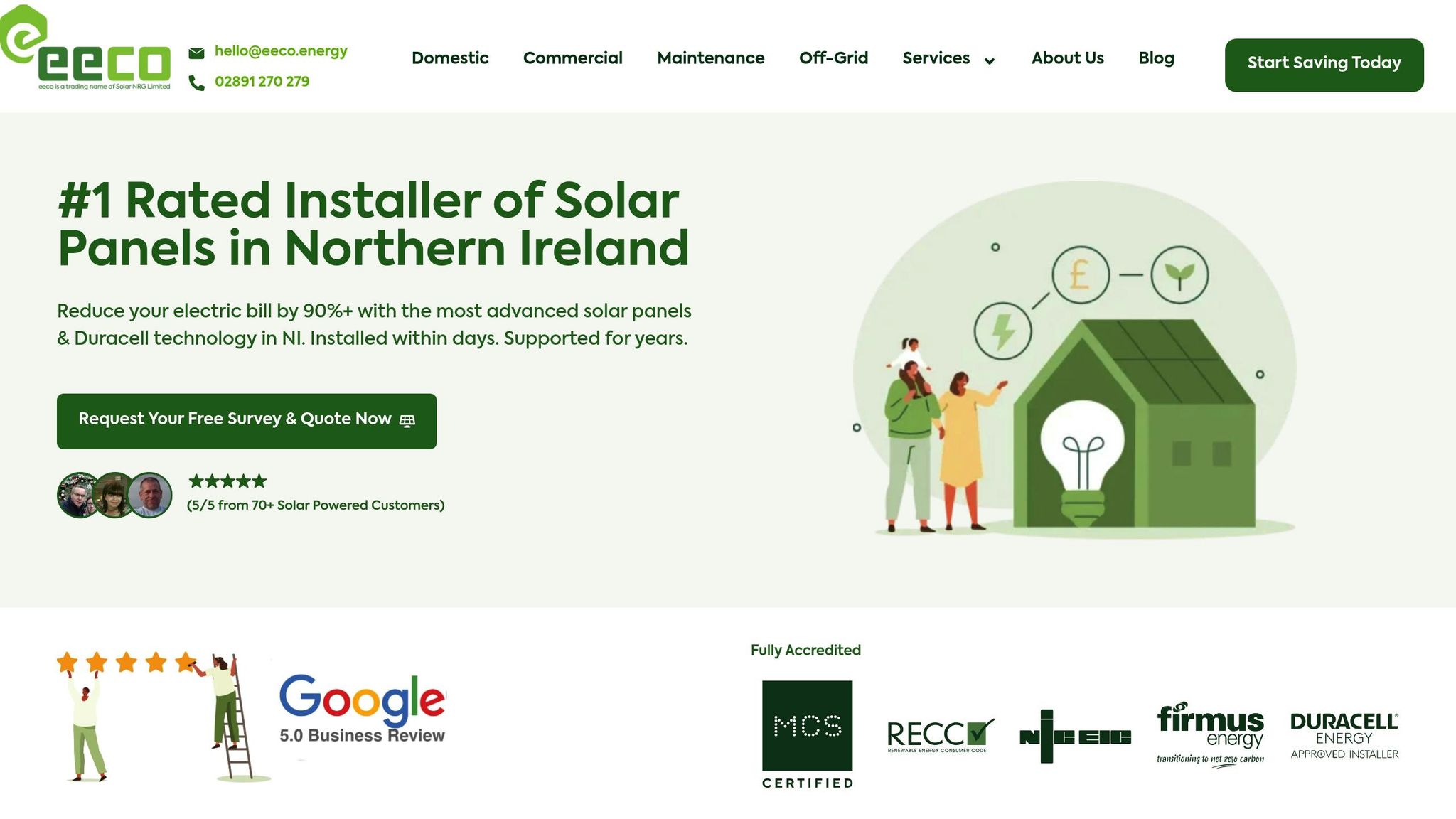
EECO Energy, an approved installer of Duracell Energy solutions in Northern Ireland, brings over a century of expertise in power storage to the region. Duracell Energy systems combine reliable performance with smart integration, making them a perfect match for modern solar setups. Below is a closer look at their key features and benefits.
Capacity
The Dura 5 and Dura 5+ models provide a storage capacity of 5.12 kWh, with the Dura 5+ offering 4.6 kWh of usable energy. For those with larger energy requirements, Duracell Energy’s 3-Phase battery system caters to commercial properties and large households. Additionally, the Duracell Home Ecosystem offers scalable storage from 14 kWh up to 56 kWh, allowing users to expand capacity as their energy needs grow. This adaptability is particularly useful in Northern Ireland, where energy usage often fluctuates with the seasons.
Efficiency
Both battery models utilise LFP (Lithium Iron Phosphate) chemistry, known for its durability and safety. The Dura 5 operates in temperatures ranging from –10°C to 50°C, while the Dura 5+ handles a broader range of –20°C to 55°C, making them well-suited to Northern Ireland’s variable weather. LFP technology is especially efficient in colder climates, maintaining capacity and charging performance even during the winter months. These batteries integrate seamlessly with a hybrid inverter (Dura‑i), an EV charger (DuraCharger), and other components via a unified smart app.
Durability and Warranty
Duracell batteries come with a 10-year warranty covering 6,000 cycles, ensuring at least 70% capacity retention over time. LFP batteries typically last 15–20 years, offering long-term reliability. The warranty can be transferred to new property owners at no extra cost, provided the battery remains connected to the internet during the coverage period. However, the warranty excludes damage caused by extreme weather, installation errors, or saltwater corrosion for properties within 200 metres of the coast.
Cost-Effectiveness
A typical 5kW system costs between £1,700 and £3,000 and can increase solar savings by 20–50%. Thanks to their modular design, these systems can be expanded gradually to meet growing energy demands. EECO Energy also provides free surveys and quotes to help customers find the most suitable battery configuration for their needs.
Compatibility
Duracell Energy systems are designed to integrate seamlessly with renewable energy sources like wind and hydro power, making them an excellent choice for rural properties in Northern Ireland. The system’s smart app enables users to monitor energy usage in real time and optimise charging during off-peak hours, reducing battery strain and enhancing efficiency. EECO Energy ensures professional installation that aligns with local electrical codes, ensuring smooth integration with existing solar systems. This compatibility aligns with the broader renewable energy initiatives discussed throughout this article.
2. Tesla Powerwall
Tesla’s Powerwall 3 is designed to enhance residential energy storage, offering a solid storage capacity and smart energy management features that fit well with Northern Ireland’s growing focus on renewable energy. Its setup allows efficient energy transfer from solar panels to the battery, keeping energy conversion losses to a minimum. Let’s break down its key features, including capacity, efficiency, durability, cost, and compatibility.
Capacity
The Powerwall 3 delivers 13.5 kWh of storage, making it a practical choice for most homes. If you need more power, you can expand the system by adding up to three extra units, each providing an additional 13.5 kWh. For many households in Northern Ireland, one or two units are enough. A single Powerwall can keep essential appliances running for 7–14 hours when paired with solar panels, or for 9–12 hours using stored energy alone.
Efficiency
The Powerwall 3 boasts an 89% round-trip efficiency and 97.5% solar-to-grid efficiency, ensuring minimal energy waste. Its built-in inverter simplifies installation, while the Time-Based Control mode helps cut costs by using stored power during peak pricing hours. It can even send surplus energy back to the grid during periods of high demand, adding to the savings [28,30]. This efficiency is particularly useful for managing energy needs during Northern Ireland’s peak demand periods.
Durability and Warranty
Tesla backs the Powerwall 3 with a 10-year warranty, guaranteeing at least 70% of its capacity over that time. The system uses lithium-iron phosphate (LFP) batteries, known for their safety and durability, even in colder climates. With a continuous power output of 11.5 kW, it can handle the energy needs of larger homes or power multiple high-demand appliances at the same time. This level of reliability is key in coping with Northern Ireland’s unpredictable weather.
Cost-Effectiveness
The Powerwall 3 is priced at around £11,500 before any incentives or taxes, with additional units available for roughly £4,400 each. While the upfront cost might seem high, government incentives can help lower the overall expense. Plus, the system’s ability to store excess solar energy for use during peak pricing periods translates into ongoing savings. The Tesla app also provides detailed energy usage insights, helping homeowners optimise their energy use and track financial benefits.
Compatibility
Tesla Powerwall systems work perfectly with both new and existing solar setups, supporting a variety of solar PV inverter brands [33,35]. Beyond solar, the system can also charge using other renewable sources like wind or hydro power, as long as they’re outside backup circuits. This flexibility is especially valuable in Northern Ireland. For backup power, Tesla suggests having at least one Powerwall for every 7.6 kW AC of solar capacity connected to the backup circuit. Next, we’ll take a closer look at another leading battery system to help you make a well-informed comparison.
3. LG Chem RESU
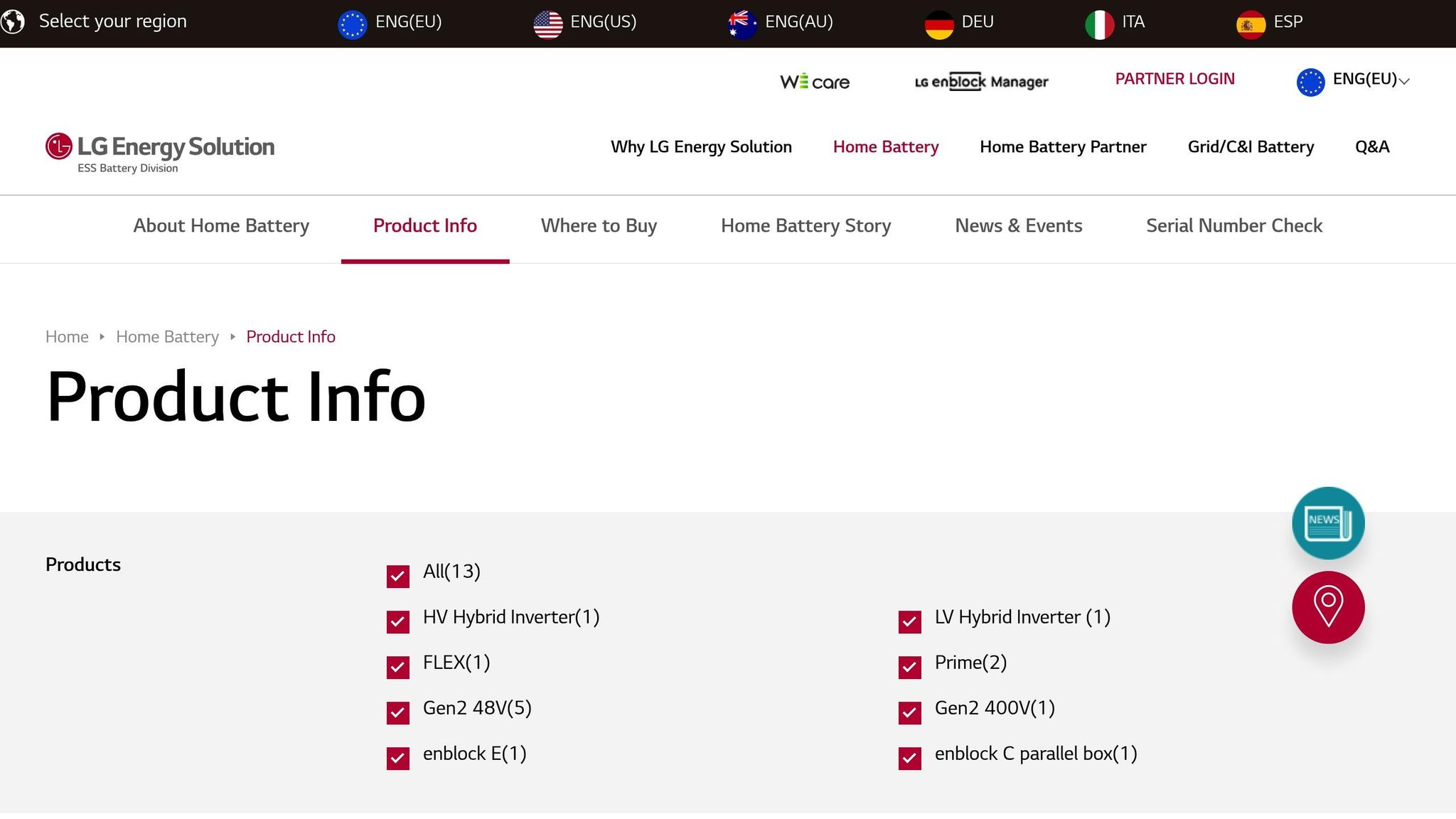
The LG Chem RESU series offers a dependable energy storage solution tailored for homes in Northern Ireland. After stepping away from the solar panel market to focus solely on energy storage systems (ESS), LG’s rebranded battery division, LG Energy Solution, has introduced products designed to provide reliable backup power and help reduce energy costs. Let’s dive into its capabilities.
Capacity
The RESU range includes models like the RESU 10H, which delivers 9.8 kWh, and the 10H Prime at 9.6 kWh. The largest option, the 16H Prime, offers a robust 16 kWh capacity. In terms of power output, the RESU 10H and 10H Prime provide 5 kW of continuous power and can peak at 7 kW. Meanwhile, the 16H Prime steps up with 7 kW of continuous power and a peak output of 11 kW.
Efficiency
These batteries use lithium-ion NMC cells, known for their reliability. The newer RESU Prime models boast a round-trip efficiency of 94.5%, meaning minimal energy is lost during charging and discharging. A depth of discharge of 95% ensures up to 95% of the battery’s capacity is usable. Additionally, an advanced battery management system (BMS) helps regulate energy flow and protects against risks like overcharging or deep discharge.
Durability and Warranty
All RESU models come with a robust 10-year warranty. For the standard RESU 10H, this includes retaining at least 60% of its original capacity after ten years or 22.4 MWh of total energy throughput. The newer Prime models go a step further, guaranteeing 70% capacity retention over the same period. Tests indicate a 16% capacity drop after three years of use.
The batteries feature an IP55-rated enclosure, which offers protection against dust and water jets. Built-in sensors monitor cell temperature and voltage, ensuring safety. To prevent overheating, the system reduces power output by 50% if internal temperatures exceed 50°C and shuts down entirely if they surpass 55°C.
Cost-Effectiveness
With prices ranging from £2,200 to £7,600, the LG Chem RESU series provides an affordable energy storage option. Models like the RESU 10H Prime and RESU 16H Prime are often seen as strong alternatives to the Tesla Powerwall, particularly for those prioritising cost savings. By storing solar energy for use during peak times or outages, these batteries help homeowners cut energy bills and maximise their investment.
Compatibility
RESU batteries integrate smoothly with existing solar systems and work with a variety of inverter brands. Whether you’re installing a new system or upgrading an older one, LG Energy Solution ensures compatibility with current and future solar technologies.
The RESU series stands out for its balance of performance, affordability, and reliability. It competes well with other leading brands, offering comparable features and warranties while maintaining competitive pricing. This makes it a popular choice among homeowners looking for value and reliability. Up next, we’ll explore another top energy storage system to see how it measures up.
4. SonnenBatterie

Sonnen, a German manufacturer, has carved out a reputation as a high-end provider in the energy storage market. Their SonnenBatterie systems are designed with a focus on safety, longevity, and optimising energy independence. These systems are particularly well-suited for homes in Northern Ireland, offering smart technology that can adapt to electricity market changes.
Capacity
Sonnen offers two main battery models to cater to different household needs. The Evo model provides a nominal capacity of 11 kWh (10 kWh usable) and can deliver up to 5 kW of power during blackouts. On the other hand, the Hybrid 9.53 model starts at 2.25 kWh and can scale up to 13.5 kWh, offering flexibility for various energy demands.
| Model | Usable Capacity |
|---|---|
| Evo | 10.0 kWh |
| Hybrid 9.53 | 2.25–13.5 kWh |
While the Evo’s capacity might not match the largest systems on the market, it remains a practical option for most households in Northern Ireland.
Efficiency
Sonnen provides transparency about its system’s real-world efficiency, which is tracked through its mobile app. These systems typically achieve 75–80% efficiency overall, taking into account factors like temperature changes and inverter losses. Sonnen also assumes a 96% inverter efficiency for both charging and discharging cycles. Self-consumption is minimal, with the standard model consuming around 15 watts and the performance version approximately 35 watts.
"The negative prices occur precisely at the time when simple storage systems are already full or the photovoltaic system simply exceeds the storage system’s capacity. The losses hit precisely when the system is feeding in a lot of power. This is immediately noticeable in terms of revenue", says Fermin Bustamante, vice president for sales and marketing DACH at Sonnen.
Durability and Warranty
One of the standout features of SonnenBatterie systems is their use of Lithium Ferro Phosphate (LFP) battery chemistry. This technology offers greater safety and stability compared to the more common Lithium NMC chemistry. LFP batteries are designed to handle up to 10,000 charge cycles while maintaining consistent performance. Sonnen backs this with a 10-year or 10,000-cycle warranty, whichever comes first, making it a reliable choice for Northern Ireland’s varied climate.
Cost-Effectiveness
SonnenBatterie systems come with a higher price tag, typically costing 25–50% more per kWh than similar systems from competitors like Sungrow or BYD. However, their advanced features allow users to charge during periods of negative electricity pricing and discharge during peak tariff times, potentially generating additional revenue that offsets the higher upfront cost.
Compatibility
SonnenBatterie systems are designed to integrate smoothly with existing solar installations and are compatible with various inverter brands. This flexibility makes them easy to retrofit into most setups. Moreover, they align with Northern Ireland’s ambitious goal of achieving 80% renewable electricity by 2030. Sonnen’s technology is also positioned to benefit from the Renewable Electricity Support Scheme (RESS), which supports Battery Energy Storage Systems through 15-year contracts for projects starting at 5 MW. Homeowners can also participate in demand response programmes and take advantage of direct marketing opportunities, bypassing traditional feed-in tariff limitations.
With its focus on intelligent energy management and seamless integration, SonnenBatterie is an excellent choice for those seeking long-term reliability and advanced energy solutions. Next, we’ll explore another high-performance battery system.
5. Huawei Luna
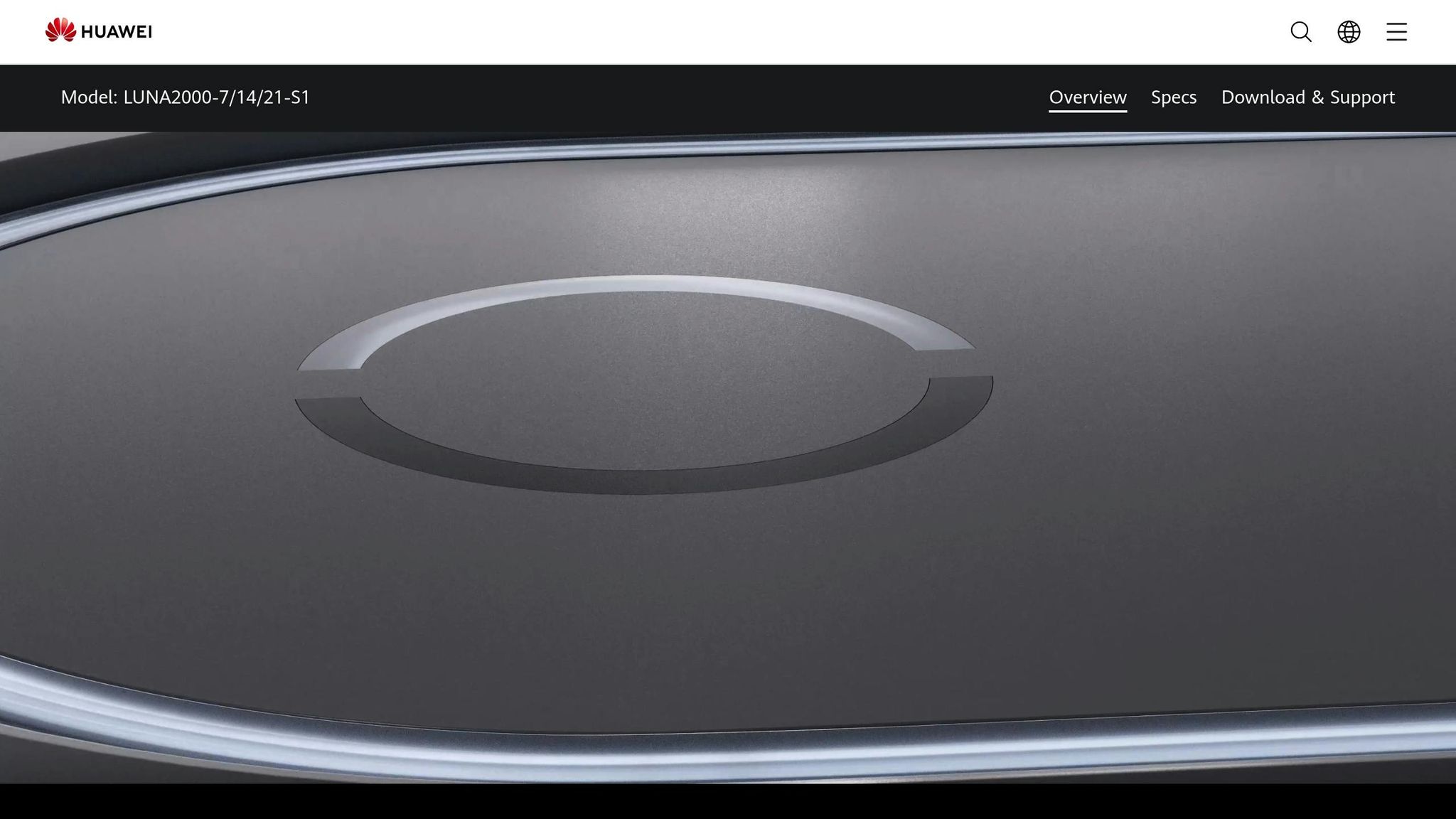
Huawei has established itself as a major force in the global energy storage market. Drawing on its expertise in telecommunications, the company delivers advanced renewable energy solutions, and its Luna2000 series showcases this commitment. Designed for both residential and commercial use, these systems are tailored to meet the needs of households and businesses across the UK and Northern Ireland.
Capacity
The Huawei Luna2000 series stands out for its modular design, which offers flexibility to suit a range of energy storage needs. For residential users, Huawei provides several model options, each catering to different energy demands:
| Model | Usable Energy/Capacity | Application |
|---|---|---|
| LUNA2000-7/14/21-S1 | 6.9 kWh – 20.7 kWh | Residential |
| LUNA2000-5/10/15-S0 | 5 kWh – 15 kWh | Residential |
| LUNA S1-7kWh | 7 kWh (expandable to 252 kWh) | Residential |
| LUNA2000-215-2S10 | 215 kWh | Commercial/Industrial |
For smaller households or moderate energy needs, the LUNA2000-5/10/15-S0 series, ranging from 5 kWh to 15 kWh, is a practical choice. Larger homes with higher energy consumption can benefit from the LUNA2000-7/14/21-S1 series, which offers capacities between 6.9 kWh and 20.7 kWh. The LUNA S1-7kWh model, however, takes flexibility to another level, as it can scale up to a massive 252 kWh, making it a future-ready option. For commercial and industrial applications, the LUNA2000-215-2S10 provides a robust 215 kWh capacity, ideal for medium to large-scale projects.
Efficiency
Huawei Luna2000 systems deliver an impressive 95% round-trip efficiency, ensuring that nearly all stored energy is converted back into usable electricity. They use Lithium Iron Phosphate (LiFePO4) battery technology, paired with Module+ Architecture and built-in energy optimisers in each module. This design boosts energy throughput by over 40% compared to traditional systems. With a 100% depth of discharge (DoD), users can access the entire stored capacity without worrying about damaging the system. Plus, the system operates quietly, with noise levels kept under 29 dB.
Durability and Warranty
The LUNA S1-7kWh residential system comes with a solid 15-year warranty. Unlike competitors, such as Tesla Powerwall, which only cover warranties down to 70% capacity, Huawei’s Luna2000 maintains coverage even if the capacity drops to 60%. The system also features individual cell monitoring, which enhances energy utilisation by over 10% throughout its lifespan. This combination of durability and advanced technology makes the Luna2000 a reliable long-term investment.
Cost-Effectiveness
Huawei Luna2000 systems are competitively priced, offering excellent value for high-performance energy storage. In Ireland, the LUNA2000-5kW-E0 Battery Module is available for €2,983.00 (excluding VAT) from Western Solar, while in the UK, Eco Wizard offers the same module for £2,600.00 (excluding VAT). The essential Battery Management System (BMS) Power Module is priced at £666.66 (excluding VAT). Thanks to its modular design, homeowners can start small and expand their system over time, spreading the cost while enjoying its efficiency and long warranty. Additionally, the system integrates seamlessly with solar installations, further enhancing its value.
Compatibility
Huawei Luna2000 systems are designed to integrate effortlessly with existing solar setups across Northern Ireland. They support both single-phase and three-phase inverters, making them suitable for a variety of property types and electrical configurations. Huawei’s FusionSolar team, active in Ireland since 2015, provides local expertise and support. Authorised suppliers like Western Solar and Eco Wizard ensure smooth delivery and technical assistance. The modular design allows for storage capacities ranging from 5 kWh to 30 kWh, and the system is also compatible with Huawei’s FusionSolar Residential Smart PV Solution, which serves over 3.3 million households globally. To optimise performance, consulting with experienced Huawei installers is recommended, especially to align with Northern Ireland’s renewable energy goals.
sbb-itb-d2d975a
Advantages and Disadvantages
Here’s a clear breakdown of the benefits and limitations of each system to help you make an informed decision.
EECO Energy Duracell Battery Systems are known for their dependable performance and local support. Their modular design is ideal for those who want to start small and scale up later. Plus, they come with a 10-year warranty. On the flip side, they may require a higher upfront investment and offer a smaller initial capacity compared to some larger commercial options.
Tesla Powerwall stands out with its impressive 13.5 kWh capacity and full 100% usable energy. Its seamless integration within Tesla’s ecosystem adds convenience, but the premium price tag and additional costs for smart features might put it out of reach for some buyers.
LG Chem RESU batteries perform well and can keep running during power outages. Their compact design and high energy density are appealing, but they come with a higher cost per kWh and require compatibility with specific inverters.
SonnenBatterie offers some of the best warranties in the market and features advanced smart energy management. Its all-in-one design simplifies installation and operation. However, these premium features come at a higher overall price.
Huawei Luna provides a budget-friendly option, boasting 95% round-trip efficiency and a modular, stackable design. The main downside is its limited compatibility, as it only works with Huawei inverters.
"The battery market is confusing with many competing claims. My advice is always to simplify it back to first principles: will it be safe and will it last? A battery built with LFP chemistry for its safety and backed by a 10 year warranty for its longevity answers both of those questions with a yes. That’s the foundation of a smart choice." – Peter Marshall, Technical Founder, Volta Eco Systems
| System Name | Capacity | Efficiency | Warranty | Cost (£) | Key Features | Compatibility | Pros | Cons |
|---|---|---|---|---|---|---|---|---|
| EECO Energy Duracell | 5–20 kWh | 95%+ | 10 years | £3,500–£7,000 | Modular design, local support | Most inverters | Reliable, expandable, local expertise | Higher initial cost, limited capacity range |
| Tesla Powerwall | 13.5 kWh | 90% | 10 years | £8,000–£12,000 | App control | Tesla ecosystem | High capacity, 100% usable capacity | Expensive, extra costs for smart features |
| LG Chem RESU | 3.3–16 kWh | 95% | 10 years | £4,000–£8,500 | Compact design, high energy density | Specific inverters | Reliable during outages, compact | Higher cost per kWh, inverter restrictions |
| SonnenBatterie | 5–20 kWh | 93% | 10–20 years | £9,000–£15,000 | Smart energy management | Widely compatible | Market‑leading warranty, all‑in‑one design | Expensive, complex features |
| Huawei Luna | 5–30 kWh | 95% | N/A | £2,600–£6,000 | Compact, stackable design | Huawei inverters only | Excellent value, high efficiency | Limited compatibility |
This comparison table provides a quick overview to help align system features with your energy needs. Balancing these trade-offs is crucial when choosing a system that suits Northern Ireland’s variable energy demands and renewable energy infrastructure.
One key consideration is the timing of installation, as costs can vary significantly. Installing a battery alongside new solar panels is much cheaper than retrofitting one to an existing system. For instance, a 5 kWh battery typically costs between £2,000 and £3,000 when installed with solar panels, compared to around £5,000 if added later.
Most systems deliver competitive round-trip efficiency of 90–95% and come with standard 10-year warranties. By carefully matching the system’s capacity, cost, and compatibility to your specific energy requirements, you can ensure the best long-term value for your investment.
Final Recommendations
Selecting the right solar battery system in Northern Ireland involves weighing performance, cost, and the region’s unique climate conditions. With Northern Ireland receiving up to 1,600 hours of sunlight annually and solar panels still functioning at 10–25% efficiency on cloudy days, adding battery storage can significantly enhance your solar investment. Here’s a breakdown of the top choices for residential, commercial, and off-grid needs.
For residential use, the EECO Energy Duracell Battery Systems are a top pick for homeowners. Their modular design allows you to start small and expand as your energy needs grow. Plus, a strong local support network ensures timely maintenance and troubleshooting. With a 10-year warranty and compatibility with a wide range of inverters, they’re well-suited to Northern Ireland’s unpredictable weather.
If you’re looking for advanced features and higher capacity, Tesla Powerwall is worth considering. With its 13.5 kWh capacity and 100% usable energy, it’s perfect for larger homes or those aiming for greater energy independence. However, its premium price tag of £8,000–£12,000 may not fit every budget.
For commercial installations, businesses might find EECO Energy Duracell systems appealing due to their scalability. Alternatively, SonnenBatterie systems are a great choice if advanced energy management features and extended warranties are a priority.
For off-grid solutions, flexibility is essential. Both Huawei Luna and EECO Energy Duracell systems offer versatile options. Huawei Luna systems feature a stackable design, though they are only compatible with Huawei inverters. Meanwhile, EECO Energy Duracell systems integrate seamlessly with a variety of components, making them ideal for comprehensive off-grid setups.
"Batteries are an effective way of running your property on green energy, even when the sun goes down."
– David Greer, Author, Action Renewables
When installing, it’s wise to work with MCS-accredited local installers. EECO Energy’s presence in the region ensures adherence to local regulations and provides reliable aftercare support.
With Northern Ireland aiming for 80% renewable electricity by 2030, investing in quality battery storage now will help you move towards greater energy independence. On top of that, adding battery storage to solar systems could save the average UK household around £665 per year.
To maximise battery efficiency, consider switching to Economy 7 or Day–Night tariffs, which allow you to charge your battery during off-peak hours.
FAQs
How can I choose the right solar battery capacity for my home in Northern Ireland?
Choosing the Right Solar Battery Capacity for Your Home in Northern Ireland
Picking the right solar battery for your home in Northern Ireland comes down to a few important considerations. Start by looking at your average daily energy consumption, measured in kilowatt-hours (kWh). You can usually find this information on your electricity bill or track it using a smart meter. Then, think about how long you want the battery to supply power during periods of low sunlight or power cuts – this is known as the autonomy period.
For most homes in Northern Ireland, a battery capacity of 10 to 20 kWh is sufficient. However, the exact size you’ll need depends on your energy usage patterns, the size of your solar panel system, and the amount of daylight your area receives. Don’t forget to check the battery’s depth of discharge (DoD), which shows how much of the battery’s capacity can be used safely without shortening its lifespan.
By considering these factors, you can choose a solar battery that ensures dependable and cost-efficient energy storage, perfectly suited to your household and Northern Ireland’s unique climate.
What are the long-term financial benefits of pairing a solar battery system with new solar panels?
Adding a solar battery system to your solar panels can dramatically cut your electricity bills – potentially saving you up to 86% over time. By storing the surplus energy your panels generate during the day, you can tap into it during the evening or peak hours. This reduces your reliance on the grid and helps shield you from rising energy prices.
But the benefits don’t stop at savings. A solar battery system gives you more control over your energy usage, boosting your independence from the grid. It’s also a smart investment for the future, especially as energy prices remain unpredictable and the UK continues its shift towards a greener, low-carbon energy system.
How does Northern Ireland’s climate impact the performance of solar battery systems?
How Northern Ireland’s Climate Affects Solar Battery Systems
Northern Ireland’s weather – marked by mild temperatures, frequent cloud cover, and higher levels of rainfall – can play a role in how solar battery systems perform. While lower sunlight levels might reduce the electricity generated by solar panels, today’s solar batteries are built to efficiently store energy, even in conditions with limited sunshine.
The region’s moderate temperature swings are another plus. Extreme heat or cold can wear down batteries over time, but Northern Ireland’s relatively stable climate helps extend their lifespan. On top of that, many solar systems are specifically designed to perform well in environments like this, offering dependable energy storage all year round.
